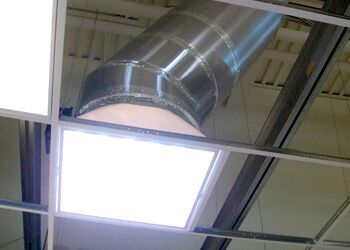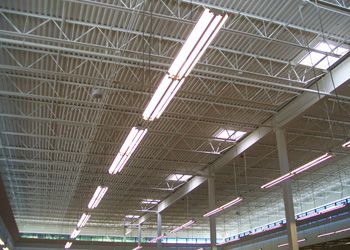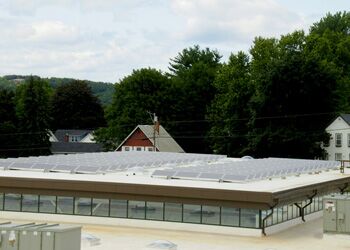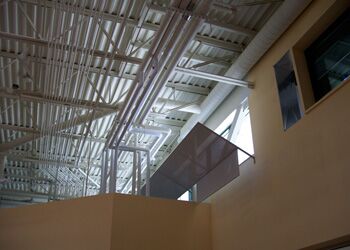In the produce section | The retail world takes note of Hannaford's platinum LEED-certified store
Nearly a year ago, Hannaford Bros. opened the first platinum LEED-certified supermarket in the country expecting that the Augusta facility would be a learning laboratory, an incubator for green technology and energy efficiencies the Scarborough-based retailer could adopt at other locations.
Although the data is still being assessed, there are enough indicators to make George Parmenter, vice president of corporate responsibility, comfortable predicting some early gains: 50% energy savings over a typical Hannaford store, 38% less water used and a heap of attention from business colleagues around the world.
“Augusta has us stepping out of our comfort zone and looking at what else we can do to decrease energy use,” says Parmenter, adding that the platinum LEED designation from the U.S. Green Building Council ratchets up Hannaford’s long-standing commitment to using energy-efficient systems. “There are a number of new things we’re trying that we haven’t done before.”
Among those innovations in the Cony Street supermarket are lots of natural light; enclosed refrigeration cases (breaking a retailer taboo by imposing a barrier between the customer and the product) with motion-sensor LED lights; ice-less seafood cases; reflective paint on the parking lot; low-flow water devices in all restrooms; a vegetated roof; geothermal wells and more. Michael Norton, the retailer’s director of corporate communications, says a typical Hannaford supermarket already has efficiencies that save about 25% in energy costs compared with most non-Hannaford supermarkets — saving an additional 50% on top of that is remarkable.“We look at it as besting the best,” says Norton.
Until performance measures are assessed on all the new green technologies, the retailer is keeping mum on how many will be integrated in new stores and in remodels of existing stores. But some early frontrunners, including solar roof panels and motion-activated lights in refrigeration units, seem destined for all future Hannaford stores, says Parmenter. The company’s newest store, in Duanesburg, N.Y., which opened two weeks ago, incorporates many of the technologies proven in Augusta.
“Food waste is the single largest waste source in our stores,” says Parmenter. “We’ve developed a composting and recycling process at Cony that is at 20 or 30 stores now, where we compost or use the waste for animal feed. That’s part of the Duanesburg store directly attributable to the Augusta store.”
The Augusta supermarket is more than a model for just other Hannaford supermarkets. Store managers have hosted tour groups since the Cony store opened last July 25, pointing out energy innovations to businesspeople, educators, environmentalists, NGOs and the general public. Among the tour group members was Jeanne von Zastrow, senior director of sustainability and industrial relations for the Food Marketing Institute, a trade association of 1,500 supermarket members representing 26,000 stores worldwide.
She says she’ll likely invite Hannaford, owned by Belgian food retailer Delhaize Group, to make a presentation this December at an FMI sustainability conference she organizes about lessons learned from the Augusta store. The information could help other executives decide which green efficiencies to adopt in their stores and how to measure returns on investment — crucial decisions as retailers face increasing pressure to embrace sustainability.
“Hannaford is a pioneer, an amazing company with a very progressive parent company and exciting programs,” says von Zastrow, who started an FMI sustainability task force in 2006 on which two Hannaford employees sit. “Sustainability has been part of their thinking for a number of years.”
Pursuing green
Driving that move toward sustainability is a consortium of public opinion, pending regulations and savvy businesses, according to FMI research. Retailers are responding to emerging green consumers, who have a growing voice in the selection of goods, as well as business operations. An FMI analysis shows 62% of consumers value recycling and sustainability efforts; 44% use reusable bags at least part of the time; 89% are interested in green products and 30% actually hunt for them; and green shoppers are twice as loyal to their main supermarket than the average consumer.
“We’re seeing overall a huge corporate commitment within our own membership … toward sustainability and energy efficiency,” says von Zastrow. “They’ve seen the successes of green stores, they’ve seen the ROI with energy efficiencies and savings for vendors and customers.”
Some have also seen the writing on the wall. As regulators become more involved in assessing the impact of sustainability, new enforcement actions are likely to follow, says von Zastrow. The Federal Trade Commission is reviewing its Green Guide to regulate green advertising claims that have exploded since 2007, while the U.S. Environmental Protection Agency, prodded by the U.S. Supreme Court, has found green house gas emissions threaten the public’s health. Many states are pushing for extended producer responsibility to make retailers verify supply chains and prove their sustainability claims go beyond using low-flow faucets. Worldwide, governments in Europe, Japan and Australia are moving toward standardized, mandatory environmental product declarations on their labels, says von Zastrow.
The push has made for some interesting bedfellows, she says. Wal-Mart has joined forces with the Environmental Defense Fund to develop best practices around waste reduction and sustainability, an example of “radical collaborations” that are transforming the retail world, von Zastrow says.
“The work Wal-Mart is doing with the Environmental Defense Fund is fabulous and it’s working so well, the EDF just opened an office in Bentonville,” she says of the site of Wal-Mart’s Arkansas headquarters. Other retail collaborations with the World Wildlife Fund, Greenpeace and the EPA are focusing on sustainability in packaging decisions, dairy processing and seafood harvests.
Hannaford adopted a buy-local campaign called Close to Home several years ago, a reflection of its commitment to Maine growers and fishermen, says Norton. Von Zastrow says she expects to return to Maine this summer to examine Hannaford’s supply chain operation, another standard in sustainable best practices among grocers.
According to a 2008 sustainability analysis by FMI, Hannaford is already ahead of the pack on several counts. FMI’s member survey revealed 8% had LEED-certified stores and 20% planned to pursue the designation. A follow-up survey taken last year shows 52% of FMI members formed sustainability teams and 31% identified sustainability programs as key initiatives for 2010.
Parmenter says he doubts Hannaford will seek another LEED platinum designation, but rather redeploy systems that work best in Augusta to other stores. “At Cony, we made a concerted effort to try a lot of different things like geothermal wells, a vegetated roof, to give us a good solid list to evaluate,” he says. “Our plan is to revisit those things and evaluate the success or failure. Platinum really works for Cony where we tried a lot of different things, but it’s not in the plans for another platinum-LEED store.”
It cost about 20% more to build the Cony store than a conventional Hannaford supermarket, says Norton. It’s likely the company will seek gold or silver LEED designations for future stores, but even that is not certain. “Certifying every new store is a huge commitment,” says Norton. “We might have stores perform to LEED-certified levels and decide not to take the step to have them certified. It’s a case-by-case decision.”
Hannaford has 173 stores throughout New England and New York and expects to continue building five to 10 new stores a year throughout the market, as it has for the past several years, says Norton. The company’s parent corporation, Delhaize Group, has been a leader in Europe in sustainable retail space, says von Zastrow. Several Delhaize officials were among the tour groups visiting Augusta.
“Having folks here from our sister companies in Europe, where there’s already a lot of activity, has been really good,” says Parmenter. “It gives us the chance to showcase what we’re doing, and share best practices with them.”
Carol Coultas, Mainebiz editor, can be reached at ccoultas@mainebiz.biz.














Comments